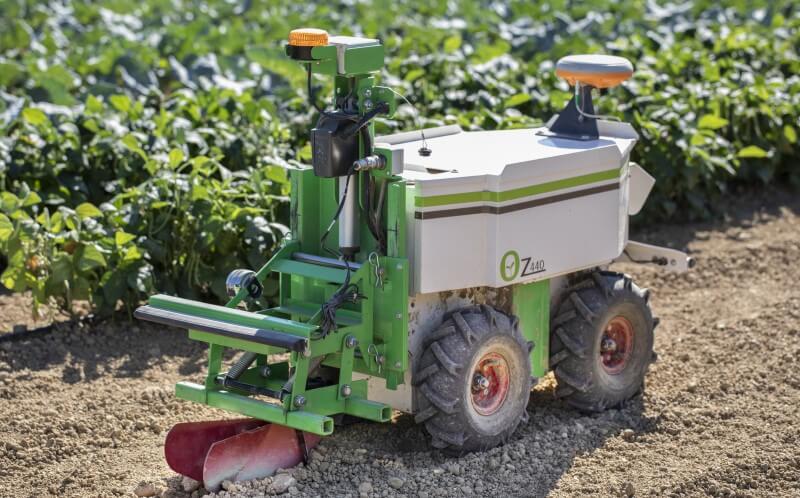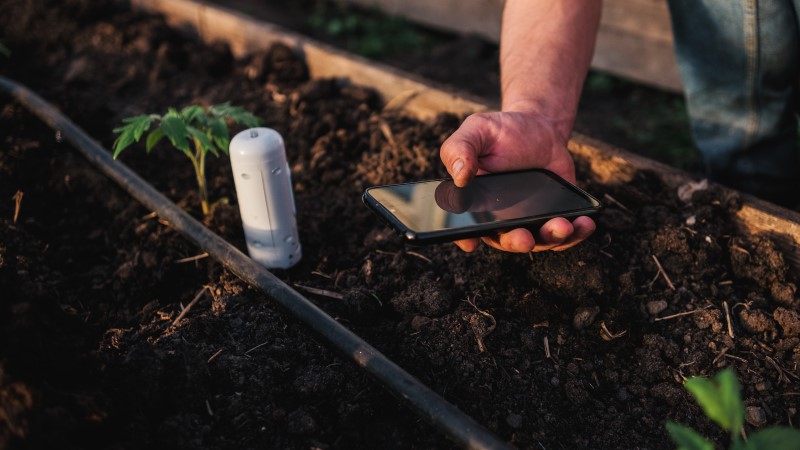At the heart of today’s smart farming revolution are sensors that provide data-driven insights and enable precision farming techniques. These sensors monitor, measure and manage the agricultural ecosystem in ever-more complex ways – without them we’re unlikely to meet the agricultural challenges of the future.
In this exploration of agricultural sensor technology, we examine some of the sensors that enable smart farming practices. From location sensors that allow precise asset tracking, to soil moisture sensors that optimise irrigation, each type plays an integral role in the search for agricultural efficiency and sustainability.
What are agricultural sensors and why are they important?
Sensors act as the eyes and ears of modern farming technology, providing real-time data on environmental conditions, soil health, crop growth and machinery performance. A sensor works by detecting physical or chemical changes in the surrounding environment, which it converts into an electrical signal. This signal is then used for information gathering or, for example, to determine whether a robot should take an action, such as watering a crop.
By harnessing the power of these sensors, farmers gain insight into every aspect of their operations, enabling informed decision-making and resource optimisation.
The use of agricultural sensors and other smart tech is helping us to overcome some of the huge challenges in agriculture. Population growth means increased demand for food, while climate change is making it harder to grow crops and raise livestock in many regions of the world. Clearly, the farmers of today must adapt to these changing conditions and develop more efficient methods of production.
Types of sensors
1. Location sensors
In the search for efficiency in agriculture, location data is paramount. Location sensors use GPS to triangulate a position, offering farmers very precise data on the spatial dynamics of their fields and assets. For example, the sensors allow mapping of fields, delineating boundaries, identifying variations in topography and optimising planting patterns.
Also, location sensors enable farmers to track the movement and utilisation of machinery and equipment. From tractors crossing the fields to drones buzzing overhead, location sensors provide real-time data on the positions and activities of agricultural assets, ensuring their efficient deployment and maintenance.
For example, the Oz farming assistant by Naïo Technologies uses real-time kinetics (RTK) GPS to help with tasks such as seeding, weeding and hoeing. The use of RTK allows a much greater degree of accuracy in terms of triangulating a position, even down to centimetre level.
 Source: Naïo Technologies
Source: Naïo Technologies
2. Dielectric soil moisture sensors
Water is vital for nourishing crops and sustaining ecosystems. Dielectric soil moisture sensors operate on the principle of dielectric permittivity, measuring the ability of soil to hold an electrical charge, which is affected by the amount of water present.
These sensors provide real-time data on soil moisture levels, enabling precise irrigation management and water conservation efforts. Also, they play a crucial role in monitoring soil health to help prevent waterlogging and soil compaction.
By maintaining optimal moisture levels, farmers can reduce the risk of crop diseases and root rot, fostering healthier and more resilient plants, and in turn higher yields.
3. Optical sensors
Maintaining optimal crop health is essential for maximising yields. Optical sensors provide information about the physiological status of a crop by using light waves to assess key indicators of plant health.
One of the primary applications is for the measurement of chlorophyll in leaves – a vital metric of photosynthetic activity and nutrient uptake. Optical sensors provide quantitative data on chlorophyll levels by analysing the reflectance and absorption patterns of light. This helps farmers to detect nutrient deficiencies and stress conditions early on.
Also, optical sensors can identify various biotic and abiotic stresses that may impact crop growth, such as pest infestations and water stress. Finally, optical sensors enable farmers to assess the efficacy of their practices and treatments by monitoring changes in plant physiology over time.
These sensors offer early warning signals, allowing farmers to implement proactive interventions and mitigate potential losses. By correlating sensor data with plant inputs, farmers can fine-tune their management strategies and optimise crop growth.
4. Biosensors
Similar to optical sensors, biosensors offer farmers insights into the physiological status of their crops and the surrounding environment.
Biosensors, equipped with biological components such as enzymes or antibodies, detect specific biological molecules or pathogens that are present in plants or soil. These sensors provide real-time data on plant health, nutrient levels and the presence of disease, enabling farmers to make informed and timely decisions about crop management and protection.
Also, biosensors play a crucial role in monitoring plant stress responses and physiological changes induced by environmental factors such as temperature fluctuations or drought. By analysing biomarkers that are indicative of stress or imbalances, biosensors help farmers to optimise growing conditions and maximise crop resilience.
5. Electrochemical sensors
Electrochemical sensors are indispensable tools for real-time monitoring of key environmental factors that are essential for plant growth and soil health.
These sensors function by converting chemical reactions into measurable electrical signals, allowing farmers to assess soil quality, detect environmental pollutants and monitor nutrient levels. They’re often mounted on land-based robots for monitoring soil health. This includes assessing pH levels, nutrient concentrations, salinity levels and the presence of any harmful pollutants, such as heavy metals.
This allows farmers to implement remediation measures for any problems at an early stage. It also allows farmers to optimise the application of fertiliser, with associated cost and environmental savings (by minimising nutrient leaching and runoff into watercourses).
6. Temperature and humidity sensors
In the delicate balance of agricultural ecosystems, temperature and humidity play crucial roles in determining crop health and productivity. Sensors that are designed to monitor these environmental factors are critical tools for optimising growing conditions and mitigating the impact of climatic fluctuations.
Temperature sensors, ranging from simple thermometers to sophisticated digital probes, provide real-time data on ambient temperatures within crop environments. By monitoring temperature variations throughout the day and across different areas of their land, farmers can identify microclimates and use targeted interventions to mitigate temperature extremes.
Similarly, humidity sensors provide data about atmospheric moisture levels, helping farmers to manage irrigation schedules, prevent fungal diseases and adjust greenhouse environments. By monitoring humidity levels within crop canopies and enclosed growing spaces, farmers can fine-tune ventilation systems to create optimal and energy-efficient growing conditions for their crops.
The integration of temperature and humidity data with advanced analytics platforms enables farmers to forecast weather patterns, anticipate crop stress events, and make data-driven decisions about irrigation, pest management and the timing of harvests.

7. Mechanical sensors
Another component of soil quality is its compaction and resistance – soil that is too compact might restrict root growth and also the ability to retain moisture.
This aspect is analysed by a mechanical sensor that is passed through the soil, with the resistance measured in terms of the pressure required to do so.
Also, there are mechanical sensors that are designed to detect and quantify mechanical deformation in components. By measuring changes in force, torque, pressure and vibration, for example, these sensors provide real-time data on the mechanical health and operational efficiency of equipment.
One of the primary applications of these mechanical sensors is to monitor repetitive stress and load cycles in components such as tractor axles, bearings and drive shafts. If any anomalies are detected, proactive maintenance can be scheduled, reducing the risk of costly breakdowns and downtime.
Are there any problems with using sensors in smart agriculture?
Alongside the many benefits described above, the use of sensors in smart agriculture also presents several challenges:
Cost
High-quality sensors can be expensive and outfitting agricultural robots with multiple sensors for various functions can significantly increase costs. This makes adoption challenging for smaller farms with limited budgets.
Calibration and maintenance
Sensors in any application, not just agriculture, require regular calibration and maintenance to ensure accuracy and reliability. In the harsh agricultural environment, sensors are susceptible to wear and tear, dust, moisture, and exposure to various contaminants. This means that adjustments and replacements are sometimes required.
Compatibility and integration
Agricultural robots can incorporate a variety of sensors from different manufacturers, leading to compatibility and integration issues. Ensuring communication and interoperability between sensors, control systems and robotic platforms can be complex.
Data overload and interpretation
Agricultural robots equipped with numerous sensors generate vast amounts of data, which can be overwhelming. Analysing and interpreting sensor data to obtain insights requires specialised expertise and sophisticated data analytics tools.
But, as with lots of modern tech, many of these issues are being addressed as the sensors evolve. Even so, it’s clear that the benefits still outweigh the challenges of using sensors in smart agriculture.
Catalysts for a greener, more resilient future
In today’s agriculture, where both maximum yield efficiency and environmental conservation are paramount, agricultural sensors are invaluable assets. They provide insights that enable farmers to nurture the soil and protect precious natural resources for future generations.
The outcome is that farmers can cultivate successful and resilient crops, maximise yields, and adapt to the dynamic challenges posed by climate change. As such, sensors aren’t just tools for measurement, but also catalysts for a greener, more resilient future.
Future developments are likely to see more cost-effective, robust and user-friendly sensor technologies tailored to the specific needs and constraints of agricultural robotics. This could involve advancements in sensor miniaturisation, wireless communication, data analytics and AI, all of which will unlock the full potential of sensors to revolutionise modern agriculture.


